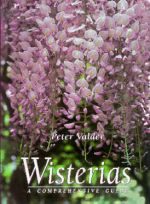|
 BOOK
REVIEWS BOOK
REVIEWS
Wisterias
A Comprehensive Guide
By Peter Valder
Published by Florilegium
Press, Australia, 1995
$NZ89.95
Reviewed by Gordon
Collier, Titoki Point, Taihape
Anyone who likes
a beautiful book as a companion will be well-satisfied with Peter
Valder's complete guide to the genus Wisteria. Everything about
this book appeals; from the design, the illustrations to the exquisite
photographs. But this slim volume will be far more to those readers
who wish to learn about this aristocratic climber or to those who
wish to make a serious study of the genus.
Wisteria is a northern
hemisphere family but paradoxically this, the first and only authoritative
publication on it was written and published in Australia. It would
be presumptuous to find fault. Peter Valder is to be congratulated
on a superlative work. Trained as a pathologist and mycologist,
the author has also lectured in botany and horticulture. It is his
interest in the latter that has brought him to public notice in
his own country and in New Zealand where his lectures have been
delivered with scholarly attention to detail. Peter Valder has applied
this same approach to his book.
Identification
is always one of the most puzzling aspects of the gardeners craft.
In the opening chapters a key is provided to the identification
of that most confusing plant, the wisteria. The technically minded
will seize on a new identification technique described.
On the pronunciation
of botanical plant names there is some timely advice:
"No one ... really
knows how the Romans pronounced Latin ... as long as whoever you
are talking to knows what you mean, then all is well".
The reader is introduced
to species scarcely known in this country. Wisteria frutescens
and W. macrostachya a late bloomer from the southern USA,
and to the so-called summer flowering wisterias, the related milletia
family three of which are native to Australia. But it is the chapters
on the Chinese and Japanese wisteria, the species most familiar
to the gardener that will captivate. The historical information
is fascinating. There are notes on cultivation and a comprehensive
and helpful description of the many cultivars.
Stunning photographs
illustrate the text throughout. Particularly evocative are the pictures
of the many ways in which the Chinese and Japanese grow this versatile
vine; over structures in the garden, as a standard, or as a dwarf
- called penjing in China and bonsai in Japan.
Peter Valder considers
the Japanese wisteria requires more care in training but to be the
most beautiful. On the basis of earlier Japanese botanical usage,
Dr Valder abandons the species W. venusta (named by Rheder
and Wilson at the Arnold Arboretum in 1916) for the earlier used
W. brachybotrys (Seibold 1835). This decision is taxonomically
correct and Trevor Davies, New Zealand's specialist, is of the same
mind. This species holds out the promise of violet, pink, and mauve-pink
cultivars waiting to be introduced. W. brachybotrys 'Showa
Beni' illustrated on page 118 is said to be the most dramatic and
a good clear pink.
There is a further
chapter on training and pruning which is most useful. Diseases and
pests, propagation, and breeding are also detailed.
Peter Valder writes
from a deep love and exhaustive knowledge of his subject. A glance
through the preface reveals just how extensive his research has
been. I was recently privileged to visit the former garden of his
family at Mount Wilson, NSW, when the wisteria were in full bloom.
I cannot recall seeing anything more magical.
Buy this book.
It is a classic.
New
Zealand Garden Journal: Journal of the Royal New Zealand Institute
of Horticulture 1997 2(1): 28
Reviews Main Page
|


 BOOK
REVIEWS
BOOK
REVIEWS